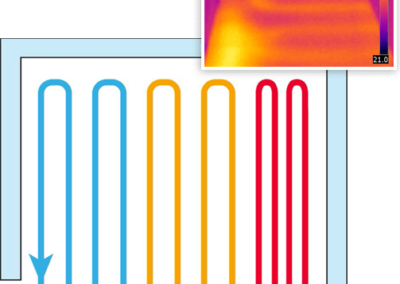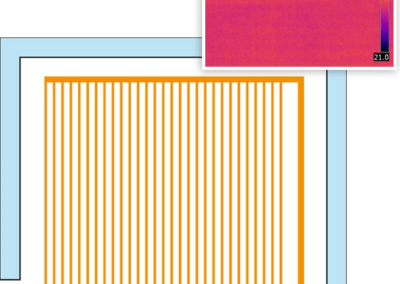Every year, summer temperatures rise and with them the need for cooling systems in the home. You don’t want a conventional air conditioner. You already know these from everyday office life or from public buildings. There’s a constant draft, you get headaches, contact lens wearers complain of dry eyes … and of course you can never agree on what room temperature is comfortable for everyone.
Floor cooling is an ideal alternative in this regard : it belongs to the types of surface cooling. The room is cooled via the surfaces (i.e. the floor) – and not via a “device” on the wall that blows at you. The best thing: with floor cooling, all people (with different temperature sensations) can feel comfortable.
Sounds like magic? That’s what our customers thought when we first told them about it…. Over the past 20 years, we ourselves have installed surface cooling systems – including floor cooling systems – in over 3500 private homes and corporate buildings. Conclusion: Everyone feels completely comfortable on hot summer days.
How exactly floor cooling works, what advantages it has over conventional air conditioning, I explain in this post. I’ll also tell you why it won’t give you cold feet ;).
How does floor cooling work?
Floor cooling belongs to the group of surface cooling systems. Cooling the floor works similarly to underfloor heating, which is one of the surface heating systems. Cool or “tempered” water flows into the rooms via floor pipes.
In order for you to understand why the ground cools and you also understand the influence of our body temperature on this cooling method, you should know the 3 types of heat transfer:
- Heat flow (convection): In heat flow, heat is transferred by flowing liquids or flowing air.
When you dry your hair with a hairdryer, the blower in the hairdryer creates an airflow, which in turn creates heat flow. - Heat conduction: In heat conduction, heat is transferred through bodies from areas of higher temperature to areas of lower temperature.
If you make yourself a coffee and put a spoon in it, the end of the spoon will warm up. The reason for this is heat conduction. - Thermal radiation: In thermal radiation, heat is transmitted by electromagnetic waves (infrared radiation). Source of radiation is a body. The warmer this body is, the more heat it radiates. You cannot see this heat radiation, but only feel the warmth. If you sit close to a campfire on a cool fall day, you’ll find the warmth radiating from the fire pleasant.
In floor cooling, the tempered water cools the surface of the floor. When you are in the room, your body has a higher temperature than the floor. As heat is transferred from areas of higher temperature to areas of lower temperature, you are transferring heat to the floor through your feet. As you release “excess” heat and your body slowly adjusts to the room temperature, you find this cooling beneficial.
Unlike a classic air conditioner, there is no cold fan here, which only acts selectively (as with convection). The surface cooling acts on the whole body.
How can you cool the water in the floor pipes?
To ensure that the water in the floor pipes is always at a comfortable temperature, you have two options:
1.) Cooling with a heat pump
The great advantage of the heat pump: you can use it for cooling (in summer) and also for heating (in winter). Make sure that other energy sources can ONLY cool and not heat.
2.) Cooling with the “natural” cold from the ground.
You can also temper the water from “natural” cold sources. Where is it coolest on hot summer days? In your basement or in the garden underground. There it is usually a pleasant 15 C°. You just need to lay the pipe system in the basement or “under” your garden. Laying “under” the garden is more possible for new construction and not for renovations. The warm water from the floor pipes then flows into the basement or underground. If it is too warm in the living room, you simply exchange the warm liquid from the living room with the cold liquid from the basement. The heating or cooling pipes are connected to each other.
Do you get cold feet from floor cooling?
A cold floor? That doesn’t sound very pleasant to you (especially as a woman)? You are not alone in these concerns…..
I assure you: No, you won’t get cold feet from a floor cooling system (if the temperature is correct) – on the contrary: you will always find the floor (even barefoot) pleasant, because there is a heat exchange between you and the floor.
In the summer, you can transfer your “excess” body heat to the water in the pipes through the floor. The “warm” water then flows back to the energy source (e.g. cooling function of the heat pump) or passive cooling source (from the ground) via the cooling circuit and is cooled again.
Thanks to the surface cooling principle, you feel completely comfortable at home: you are neither too cold nor too hot.
An important additional tip from us: for a pleasant feeling, however, do not set your floor cooling to almost frosty temperatures. A floor that is too cold can be detrimental to your health – you can catch a chill, get cold feet, and this leads to abdominal problems, especially for women. In addition, condensation can settle on the floor.
What are the advantages of floor cooling (compared to air conditioning)
- Protects health: a floor cooling system works without a fan. You won’t get too cold, you won’t get chilled easily, the air in the room – and also your mucous membranes – won’t dry out, no dust will be stirred up.
- Less cost: In order for the floor to reach a comfortable temperature, the cooling system requires much less energy input – and almost none if cooling is done passively from the ground or basement. This will save you energy costs in the long run.
- No noise: You hear air conditioning all the time. The flowing water in the floor does not.
- The “right” temperature for everyone: Imagine sitting in the living room with the whole family and there are no discussions about whether the window should be open or closed. Everyone feels good all around.
I also explain all the advantages in detail in a video:
What do you need to pay attention to when installing and buying a floor cooling system?
You are already convinced and now you want to use floor cooling in your own home? Before you start googling for suppliers or do-it-yourself systems, you should ask yourself the following questions:
- How “big” should the floor cooling system be?
- Which rooms do you want to temper with it?
- How many square meters of floor exactly?
- What is the possible build-up height?
- Do you need it for a new or old apartment?
- What flooring do you want or is available?
- Are you installing the floor cooling yourself or an installer?
- Should the floor cooling system be installed in a wet screed system or a drywall system?
- Should the floor cooling pipes be laid serially (serpentine, helical) or parallel (Tichelmann system)?
- How to fix the pipes?
- Do you want to cool with an active or passive energy source?
Some of these questions you will be able to answer right away, such as whether you live in an old building or new construction. But do you know which system is suitable for an old building floor and which is not? Before you install a floor cooling system yourself, you should seek the advice of a professional beforehand. This will help you to clarify the above issues with all the implications.
You are already overwhelmed with these questions? Imagine if there was a system where you didn’t have to worry about all these questions….
You probably already realize where this is going – now let’s do some advertising 😉
egger floor cooling: Cost-effective cooling in all buildings
At the beginning of this article, we mentioned that we ourselves have been integrating surface cooling and heating systems for over 20 years. What sets our egger system apart from other floor cooling systems – it is suitable for any floor, any type of construction, any building, and any energy source. In addition, you can cool as well as heat with the egger system. Best of all, unlike conventional underfloor cooling (and underfloor heating) systems, egger underfloor cooling pipes are laid parallel – not serpentine. (You can read more about the differences in this article: Cooling with Tichelmann or snake system).
In summary, this means that thanks to the parallel system, the floors are cooled (and heated) more evenly, more quickly and more cost-effectively.
You have more questions about floor cooling from egger Wohlfühl-Klima?
You are curious now and have further questions about the egger system for your home? We will be happy to help you during a free consultation. You can contact us by phone(+43 5223 411 68 11), by e-mail or by using the contact form.
You can also buy the complete egger system for your underfloor cooling (or underfloor heating) at home directly in our egger store. For self-assembly, of course, you get step-by-step instructions.
Love greetings
Annette & Christian Egger





